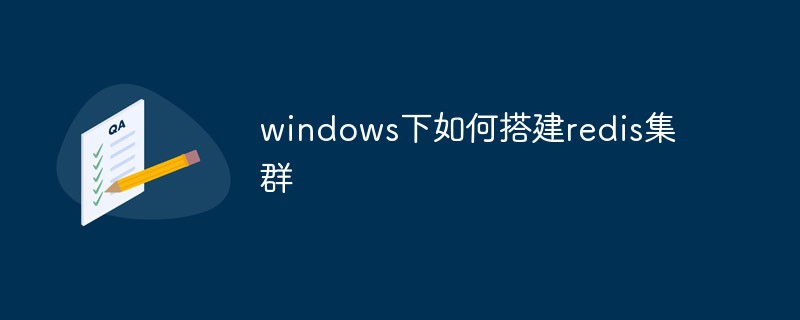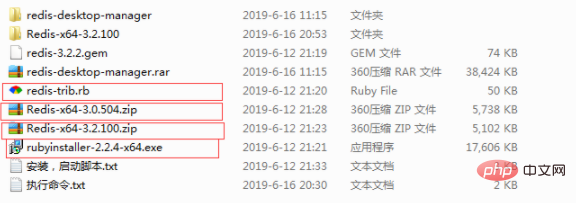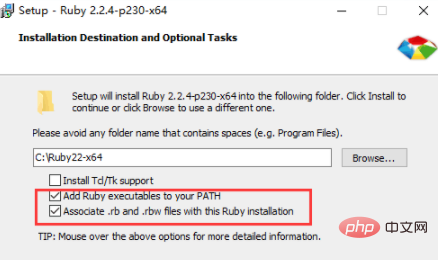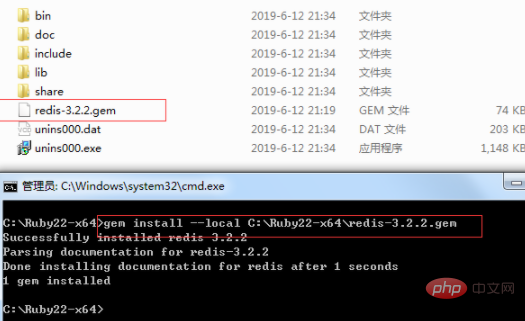How to build a redis cluster under windows
- 王林forward
- 2021-03-05 09:28:562151browse

Foreword:
Clustering refers to providing the same service by adding the number of servers, so as to achieve a stable and efficient state. Why use redis cluster? The redis cluster can enhance the reading and writing capabilities of redis.
Now let’s formally learn about redis cluster.
Preparation work:
Requires 4 components: Redis, Ruby language runtime environment, Redis Ruby driver redis-xxxx.gem, and the tool to create a Redis cluster redis-trib.rb. Use the redis-trib.rb tool to create a Redis cluster. Since this file is written in ruby language, you need to install the Ruby development environment and drive redis-xxxx.gem.

1) Download the Redis installation file: https://github.com/MSOpenTech/redis/releases/, Redis provides download files in msi and zip formats, download zip here Format Redis-x64-3.2.100 version.
2) Download the Ruby installation file: http://dl.bintray.com/oneclick/rubyinstaller/rubyinstaller-2.2.4-x64.exe
3) Download Redis in the Ruby environment Driver: https://rubygems.org/gems/redis/versions/3.2.2. Considering compatibility, the 3.2.2 version is downloaded here.
Note: Download the related link in the lower right corner of the page.中

4) Download the ruby script file redis-trib.rb officially provided by Redis to create a Redis cluster. The path is as follows: https://raw.githubusercontent.com/MSOpenTech /redis/3.0/src/redis-trib.rb
Install Redis
Just decompress the downloaded Redis-x64-3.2.100.zip. For ease of use, it is recommended to put it in In the root directory of the drive letter, such as: D:\Redis-Cluster\Redis-x64-3.2.100.
Install Redis and run 3 instances (Redis cluster requires at least 3 nodes, less than 3 cannot be created);
Start 6 different Redis instances through configuration files, Since the default port of Redis is 6379, 6380, 6381, 6382, 6383, 6384, and 6385 are used here to run 6 Redis instances.
Note:
(1) In order to avoid unnecessary errors, try to save the configuration file in utf8 format and do not include comments;
(2) The following in the configuration file There are two ways to save logs (save in files and save in System Log). Please choose one according to your needs:
loglevel notice #日志的记录级别,notice是适合生产环境的 logfile "D:/Redis-Cluster/Redis-x64-3.2.100/Logs/redis6380_log.txt" #指定log的保持路径,默认是创建在Redis安装目录下,如果有子目录需要手动创建,如此处的Logs目录 syslog-enabled yes #是否使用系统日志 syslog-ident redis6380 #在系统日志的标识名
The method of saving in files is used here, so first save in the Redis directory Create a new Logs folder under D:\Redis-Cluster\Redis-x64-3.2.100.
In the root directory of the Redis installation, create configuration files with encoding format utf-8: redis.6380.conf, redis.6381.conf, redis.6382.conf, redis.6383.conf, redis. 6384.conf, redis.6385.conf.
redis.6380.conf、
port 6380 loglevel notice logfile "D:/Redis-Cluster/Redis-x64-3.2.100/Logs/redis6380_log.txt" appendonly yes appendfilename "appendonly.6380.aof" cluster-enabled yes cluster-config-file nodes.6380.conf cluster-node-timeout 15000 cluster-slave-validity-factor 10 cluster-migration-barrier 1 cluster-require-full-coverage yes
redis.6381.conf、
port 6381 loglevel notice logfile "D:/Redis-Cluster/Redis-x64-3.2.100/Logs/redis6381_log.txt" appendonly yes appendfilename "appendonly.6381.aof" cluster-enabled yes cluster-config-file nodes.6381.conf cluster-node-timeout 15000 cluster-slave-validity-factor 10 cluster-migration-barrier 1 cluster-require-full-coverage yes
redis.6382.conf、
port 6382 loglevel notice logfile "D:/Redis-Cluster/Redis-x64-3.2.100/Logs/redis6382_log.txt" appendonly yes appendfilename "appendonly.6382.aof" cluster-enabled yes cluster-config-file nodes.6382.conf cluster-node-timeout 15000 cluster-slave-validity-factor 10 cluster-migration-barrier 1 cluster-require-full-coverage yes
redis.6383.conf、
port 6383 loglevel notice logfile "D:/Redis-Cluster/Redis-x64-3.2.100/Logs/redis6383_log.txt" appendonly yes appendfilename "appendonly.6383.aof" cluster-enabled yes cluster-config-file nodes.6383.conf cluster-node-timeout 15000 cluster-slave-validity-factor 10 cluster-migration-barrier 1 cluster-require-full-coverage yes
redis.6384.conf、
port 6384 loglevel notice logfile "D:/Redis-Cluster/Redis-x64-3.2.100/Logs/redis6384_log.txt" appendonly yes appendfilename "appendonly.6384.aof" cluster-enabled yes cluster-config-file nodes.6384.conf cluster-node-timeout 15000 cluster-slave-validity-factor 10 cluster-migration-barrier 1 cluster-require-full-coverage yes
redis.6385.conf
port 6385 loglevel notice logfile "D:/Redis-Cluster/Redis-x64-3.2.100/Logs/redis6385_log.txt" appendonly yes appendfilename "appendonly.6385.aof" cluster-enabled yes cluster-config-file nodes.6385.conf cluster-node-timeout 15000 cluster-slave-validity-factor 10 cluster-migration-barrier 1 cluster-require-full-coverage yes
(Learning video sharing: redis video tutorial)
The configuration is explained as follows:
port 6380 #端口号 loglevel notice #日志的记录级别,notice是适合生产环境的 logfile "Logs/redis6380_log.txt" #指定log的保持路径,默认是创建在Redis安装目录下,如果有子目录需要手动创建,如此处的Logs目录 syslog-enabled yes #是否使用系统日志 syslog-ident redis6380 #在系统日志的标识名 appendonly yes #数据的保存为aof格式 appendfilename "appendonly.6380.aof" #数据保存文件 cluster-enabled yes #是否开启集群 cluster-config-file nodes.6380.conf cluster-node-timeout 15000 cluster-slave-validity-factor 10 cluster-migration-barrier 1 cluster-require-full-coverage yes
Save the above configuration files to the Redis directory, and use these configuration files to install 6 A redis service, the command is as follows:
D:/Redis-Cluster/Redis-x64-3.2.100/redis-server.exe --service-install D:/Redis-Cluster/Redis-x64-3.2.100/redis.6380.conf --service-name redis6380 D:/Redis-Cluster/Redis-x64-3.2.100/redis-server.exe --service-install D:/Redis-Cluster/Redis-x64-3.2.100/redis.6381.conf --service-name redis6381 D:/Redis-Cluster/Redis-x64-3.2.100/redis-server.exe --service-install D:/Redis-Cluster/Redis-x64-3.2.100/redis.6382.conf --service-name redis6382 D:/Redis-Cluster/Redis-x64-3.2.100/redis-server.exe --service-install D:/Redis-Cluster/Redis-x64-3.2.100/redis.6383.conf --service-name redis6383 D:/Redis-Cluster/Redis-x64-3.2.100/redis-server.exe --service-install D:/Redis-Cluster/Redis-x64-3.2.100/redis.6384.conf --service-name redis6384 D:/Redis-Cluster/Redis-x64-3.2.100/redis-server.exe --service-install D:/Redis-Cluster/Redis-x64-3.2.100/redis.6385.conf --service-name redis6385
Note:
1) It is best to use the full path for configuration files such as redis.6380.conf to avoid problems when restarting the Redis cluster
2) The uninstall command is:
D:/Redis-Cluster/Redis-x64-3.2.100/redis-server.exe --service-uninstall D:/Redis-Cluster/Redis-x64-3.2.100/redis.6380.conf --service-name redis6380 D:/Redis-Cluster/Redis-x64-3.2.100/redis-server.exe --service-uninstall D:/Redis-Cluster/Redis-x64-3.2.100/redis.6381.conf --service-name redis6381 D:/Redis-Cluster/Redis-x64-3.2.100/redis-server.exe --service-uninstall D:/Redis-Cluster/Redis-x64-3.2.100/redis.6382.conf --service-name redis6382 D:/Redis-Cluster/Redis-x64-3.2.100/redis-server.exe --service-uninstall D:/Redis-Cluster/Redis-x64-3.2.100/redis.6383.conf --service-name redis6383 D:/Redis-Cluster/Redis-x64-3.2.100/redis-server.exe --service-uninstall D:/Redis-Cluster/Redis-x64-3.2.100/redis.6384.conf --service-name redis6384 D:/Redis-Cluster/Redis-x64-3.2.100/redis-server.exe --service-uninstall D:/Redis-Cluster/Redis-x64-3.2.100/redis.6385.conf --service-name redis6385
Start these 6 services. The command is as follows:
D:/Redis-Cluster/Redis-x64-3.2.100/redis-server.exe --service-start --service-name redis6380 D:/Redis-Cluster/Redis-x64-3.2.100/redis-server.exe --service-start --service-name redis6381 D:/Redis-Cluster/Redis-x64-3.2.100/redis-server.exe --service-start --service-name redis6382 D:/Redis-Cluster/Redis-x64-3.2.100/redis-server.exe --service-start --service-name redis6383 D:/Redis-Cluster/Redis-x64-3.2.100/redis-server.exe --service-start --service-name redis6384 D:/Redis-Cluster/Redis-x64-3.2.100/redis-server.exe --service-start --service-name redis6385
Execution result:


gem install --local path_to_gem/filename.gem

D:/Redis-Cluster/Redis-x64-3.2.100/redis-trib.rb create --replicas 1 127.0.0.1:6380 127.0.0.1:6381 127.0.0.1:6382 127.0.0.1:6383 127.0. 0.1:6384 127.0.0.1:6385
D:\Redis-Cluster\Redis-x64-3.2.100>redis-trib.rb create --replicas 1 127.0.0.1:6380 127.0.0.1:6381 127.0.0.1:6382 127.0.0.1:6383 127.0.0.1:6384 127.0.0.1:6385 >>> Creating cluster Connecting to node 127.0.0.1:6380: OK Connecting to node 127.0.0.1:6381: OK Connecting to node 127.0.0.1:6382: OK Connecting to node 127.0.0.1:6383: OK Connecting to node 127.0.0.1:6384: OK Connecting to node 127.0.0.1:6385: OK >>> Performing hash slots allocation on 6 nodes... Using 3 masters: 127.0.0.1:6380 127.0.0.1:6381 127.0.0.1:6382 Adding replica 127.0.0.1:6383 to 127.0.0.1:6380 Adding replica 127.0.0.1:6384 to 127.0.0.1:6381 Adding replica 127.0.0.1:6385 to 127.0.0.1:6382 M: bb6ef615bb0ae13275943caec0db9d30b9f35c5e 127.0.0.1:6380 slots:0-5460 (5461 slots) master M: b4d120f2983ad683f7b68992e1ba414722238db7 127.0.0.1:6381 slots:5461-10922 (5462 slots) master M: 837779b3965e2c9d4dd4385750aaaaf9a9039fb0 127.0.0.1:6382 slots:10923-16383 (5461 slots) master S: 5d154137180284d926ef51a91fc75f9438249ef8 127.0.0.1:6383 replicates bb6ef615bb0ae13275943caec0db9d30b9f35c5e S: ad151680a3e36cf2083ef822be0bdb075a7d36de 127.0.0.1:6384 replicates b4d120f2983ad683f7b68992e1ba414722238db7 S: 9a2260a5a6a2add84b622a453a6a7b86a29d180d 127.0.0.1:6385 replicates 837779b3965e2c9d4dd4385750aaaaf9a9039fb0 Can I set the above configuration? (type 'yes' to accept): yes >>> Nodes configuration updated >>> Assign a different config epoch to each node >>> Sending CLUSTER MEET messages to join the cluster Waiting for the cluster to join... >>> Performing Cluster Check (using node 127.0.0.1:6380)M: bb6ef615bb0ae13275943caec0db9d30b9f35c5e 127.0.0.1:6380 slots:0-5460 (5461 slots) master M: b4d120f2983ad683f7b68992e1ba414722238db7 127.0.0.1:6381 slots:5461-10922 (5462 slots) master M: 837779b3965e2c9d4dd4385750aaaaf9a9039fb0 127.0.0.1:6382 slots:10923-16383 (5461 slots) master M: 5d154137180284d926ef51a91fc75f9438249ef8 127.0.0.1:6383 slots: (0 slots) master replicates bb6ef615bb0ae13275943caec0db9d30b9f35c5e M: ad151680a3e36cf2083ef822be0bdb075a7d36de 127.0.0.1:6384 slots: (0 slots) master replicates b4d120f2983ad683f7b68992e1ba414722238db7 M: 9a2260a5a6a2add84b622a453a6a7b86a29d180d 127.0.0.1:6385 slots: (0 slots) master replicates 837779b3965e2c9d4dd4385750aaaaf9a9039fb0 [OK] All nodes agree about slots configuration. >>> Check for open slots... >>> Check slots coverage... [OK] All 16384 slots covered.Remarks:
(1)--replicas #指定集群中每个主节点配备几个从节点,这里设置为1。
(2)redis-trib.rb工具的使用
、create:创建集群 、check:检查集群 、info:查看集群信息 、fix:修复集群 、reshard:在线迁移slot 、rebalance:平衡集群节点slot数量 、add-node:将新节点加入集群 、del-node:从集群中删除节点 、set-timeout:设置集群节点间心跳连接的超时时间 、call:在集群全部节点上执行命令 、import:将外部redis数据导入集群
(2)检验是否真的创建成功
输入以下命令:
redis-trib.rb check 127.0.0.1:6380
如果现实信息如下,则说明创建的Redis集群是没问题。
D:\Redis-Cluster\Redis-x64-3.2.100>redis-trib.rb check 127.0.0.1:6380 Connecting to node 127.0.0.1:6380: OK Connecting to node 127.0.0.1:6383: OK Connecting to node 127.0.0.1:6382: OK Connecting to node 127.0.0.1:6384: OK Connecting to node 127.0.0.1:6385: OK Connecting to node 127.0.0.1:6381: OK >>> Performing Cluster Check (using node 127.0.0.1:6380) M: bb6ef615bb0ae13275943caec0db9d30b9f35c5e 127.0.0.1:6380 slots:0-5460 (5461 slots) master 1 additional replica(s) S: 5d154137180284d926ef51a91fc75f9438249ef8 127.0.0.1:6383 slots: (0 slots) slave replicates bb6ef615bb0ae13275943caec0db9d30b9f35c5e M: 837779b3965e2c9d4dd4385750aaaaf9a9039fb0 127.0.0.1:6382 slots:10923-16383 (5461 slots) master 1 additional replica(s) S: ad151680a3e36cf2083ef822be0bdb075a7d36de 127.0.0.1:6384 slots: (0 slots) slave replicates b4d120f2983ad683f7b68992e1ba414722238db7 S: 9a2260a5a6a2add84b622a453a6a7b86a29d180d 127.0.0.1:6385 slots: (0 slots) slave replicates 837779b3965e2c9d4dd4385750aaaaf9a9039fb0 M: b4d120f2983ad683f7b68992e1ba414722238db7 127.0.0.1:6381 slots:5461-10922 (5462 slots) master 1 additional replica(s) [OK] All nodes agree about slots configuration. >>> Check for open slots... >>> Check slots coverage... [OK] All 16384 slots covered. D:\Redis-Cluster\Redis-x64-3.2.100>
(3)信息查询
使用Redis客户端Redis-cli.exe来查看数据记录数,以及集群相关信息

原文作者:cctext
原文链接:https://www.cnblogs.com/yy3b2007com/p/11033009.html
相关推荐:redis数据库教程
The above is the detailed content of How to build a redis cluster under windows. For more information, please follow other related articles on the PHP Chinese website!

